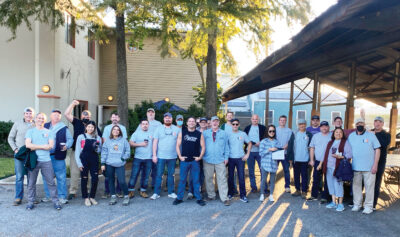
About the Author:
Michael Culbreth, Pennsylvania Lumbermens Mutual Insurance Company, is a loss control services consultant based in Inman, South Carolina who joined PLM in 2002. He protects businesses in territories including North Carolina and South Carolina. Michael can be reached at mculbreth@plmins.com or by phone at (267) 825-9146.
The wood manufacturing industry has a reputation for its hazardous nature. Combustible dust, sparks from welding and hot work activity and use of heavy machinery are just a few of the common risks manufacturers face that have the potential to compromise employee safety and cause catastrophic fires, property damage and business interruption. Fortunately, technological innovation offers Hardwood manufacturers tools to help mitigate risks and promote safer operations.
While the lumber industry may have initially been slow to adopt tech tools, more manufacturers are recognizing the value of infrared technology, specialized dust control fan systems and fleet telematics to increase efficiency as well as safety. Manufacturers have come to understand that technology can play a key role in reducing risk exposures and in improving safety across facilities.
Infrared Technology: Even when abiding by necessary codes, regulations, and safety practices, the risk of an electrical fire is elevated in a wood manufacturing business. Wood dust, high voltage electric panel boxes, cords, heavy machinery and overheating conditions all set ideal scenarios for a small spark to turn into a blaze.
An electrical hotspot can occur when a loose connection emits heat. This type of overheating condition is not normally visible and would only be identified during an infrared scan. Many Hardwood manufacturers are investing in infrared technology as a way to identify electrical hot spots that can develop over time.
Fortunately, some electricians and insurance loss control representatives are equipped with infrared cameras and have been trained and certified in thermography. Infrared thermography companies also provide this valuable service on a full-time basis. It is important to have a certified thermographer complete the scan and recommend the appropriate repair needs based on the overheating conditions identified. While some business owners are buying their own infrared cameras to check for hotspots, those completing scans need to be well trained and certified in how to conduct the scan and interpret the results. Failing to perform or interpret a scan correctly could provide a false sense of security and lead to a fire incident
There are additional benefits to infrared thermography beyond improved fire safety. Energy savings result from identifying and repairing electrical hotspots which involve excess power consumption. The lifespan of motors and equipment are also favorably impacted by eliminating overheating electrical conditions.
Dust Management Technology: As many in the industry know, combustible dust continues to be a top concern for wood manufacturers. As dust accumulates (even in small layers) and goes unnoticed or ignored, the threat of a fire or explosion increases significantly. Fortunately, the Occupational Safety & Health Administration (OSHA) provides guidance and a National Emphasis Program (NEP) to help manufacturers maintain safe operations.
Along with a strong housekeeping program, a main line of defense against dust accumulation will often include specialized fans, which prevent dust layering in overhead areas. Overhead dust layering is difficult, dangerous and time-consuming to clean. The use of air barrier type fans helps to prevent overhead dust layering before it begins and can be an effective long-term solution for dust control.
Technology is also available and commonly used to protect against sparks entering the ductwork on a fixed dust collection system. Fires involving dust collection systems unfortunately occur each year, resulting from sparks caused by tramp metal, friction, static and hot work among other causes. A spark detection/flame suppression system can be highly effective in mitigating this hazard. Infrared detectors identify sparks inside the duct and a water nozzle extinguishes the spark within milliseconds, and before it can reach the dust collector and begin to smolder. These valuable fire protection systems do require ongoing testing and maintenance based on the manufacturer specifications to ensure dependable and reliable operation.
Fleet Safety Technology: Risk exposures related to fleet safety have increased in recent years as more novice drivers join the workforce amid labor shortages. To protect themselves, business owners should consider implementing tools to better manage and improve their fleet operations and properly train their drivers.
Telematics is a proven way for business owners to manage their fleets, identify problem driving habits and improve overall performance and safety. Vehicle cameras and GPS sensor devices placed inside the vehicle track factors such as speed, hard braking, fast acceleration and other driving behaviors. The more advanced systems offer artificial intelligence (AI) capabilities that can identify distracted driving, or other dangerous behaviors. This data is transmitted wirelessly back to the company and can be used for counseling and training purposes to improve safe driver performance.
Maintenance
Hardwood manufacturers need to ensure their technology is kept in good working order and is not neglected after being purchased and installed.
Most technological tools such as specialized dust control fans or spark detection/flame suppression systems will have manufacturer recommendations for set-up, maintenance, testing and sometimes training. It is crucial that business owners abide by those recommendations. Remember that technology, although very helpful, does have its limitations.
With the wide range of tech tools available to Hardwood manufacturers, the hardest part of the process could be choosing one. Consider consulting industry peers who have gone through the process before or attending trade shows to get a full picture of the options available. Technology has the ability to considerably improve the safety conditions and efficiency of the Hardwood industries. Begin by consulting your insurer for a thorough risk assessment to identify the exposures unique to your business. A specialty insurer who understands the nuanced risks facing Hardwood manufacturers can be a great resource when choosing and implementing tech tools. May it be your goal to know your risk, take advantage of the many risk mitigation resources available to your business and stay safe.






